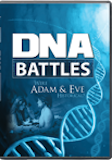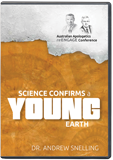
DNA in “Ancient” Bacteria
Best Evidences From Science That Confirm a Young Earth
Scientists were surprised to find that DNA was still intact after a supposed 250 million years.
In 2000, scientists claimed to have “resurrected” bacteria, named Lazarus bacteria, discovered in a salt crystal conventionally dated at 250 million years old. They were shocked that the bacteria’s DNA was very similar to modern bacterial DNA. If the modern bacteria were the result of 250 million years of evolution, its DNA should be very different from the Lazarus bacteria (based on known mutation rates).
In addition, the scientists were surprised to find that the DNA was still intact after the supposed 250 million years. DNA normally breaks down quickly, even in ideal conditions. Even evolutionists agree that DNA in bacterial spores (a dormant state) should not last more than a million years. Their quandary is quite substantial.
However, the discovery of Lazarus bacteria is not shocking or surprising when we base our expectations on the Bible accounts. For instance, Noah’s Flood likely deposited the salt beds that were home to the bacteria. If the Lazarus bacteria are only about 4,500 years old (the approximate number of years that have passed since the worldwide flood), their DNA is more likely to be intact and similar to modern bacteria.
Rescuing Devices
Some scientists have dismissed the finding and believe the Lazarus bacteria are contamination from modern bacteria. But the scientists who discovered the bacteria defend the rigorous procedures used to avoid contamination. They claim the old age is valid if the bacteria had longer generation times, different mutation rates, and/or similar selection pressures compared to modern bacteria. Of course these “rescuing devices” are only conjectures to make the data fit their worldview.
Resources
Andy Coghlan, “Eternal Life,” New Scientist, October 18, 2000, http://www.newscientist.com/article/dn82-eternal-life.html.
Russell H. Vreeland, William D. Rosenzweig, and Dennis W. Powers, “Isolation of a 250 million-year-old Halotolerant Bacterium from a Primary Salt Crystal,” Nature 407 (2000): 897–900, http://www.nature.com/nature/journal/v407/n6806/abs/407897a0.html (link to abstract).
R. H. Vreeland and W. D. Rosenzweig, “The Question of Uniqueness of Ancient Bacteria,” Journal of Industrial Microbiology and Biotechnology, 28 (2002): 32–41, https://link.springer.com/article/10.1038/sj/jim/7000174.
David C. Nickle, et al., “Curiously Modern DNA for a “250 million-year-old” Bacterium,” Journal of Molecular Evolution 54 (2002): 134–137, http://www.ncbi.nlm.nih.gov/pubmed/11734907 (link to abstract).
Answers Magazine
October – December 2012
God’s Word clearly teaches that the earth is young, and the evidence powerfully confirms it. So don’t miss this issue of Answers, which brings you up to speed on the ten best evidences for a young earth. Also discover incredible new examples of the Creator’s undeniable designs, a biblical view on political activism, the latest findings on the Dead Sea scrolls, and much more!
Browse IssueRecommended Resources

Answers in Genesis is an apologetics ministry, dedicated to helping Christians defend their faith and proclaim the good news of Jesus Christ.
- Customer Service 800.778.3390
- Available Monday–Friday | 9 AM–5 PM ET
- © 2025 Answers in Genesis




